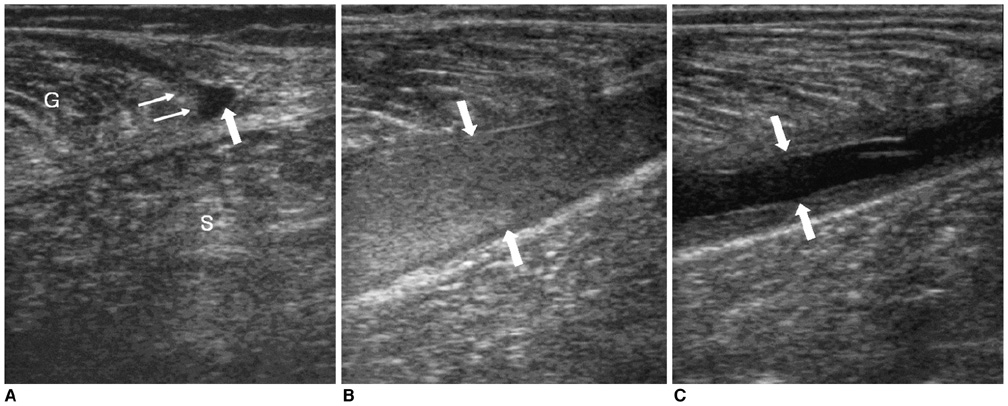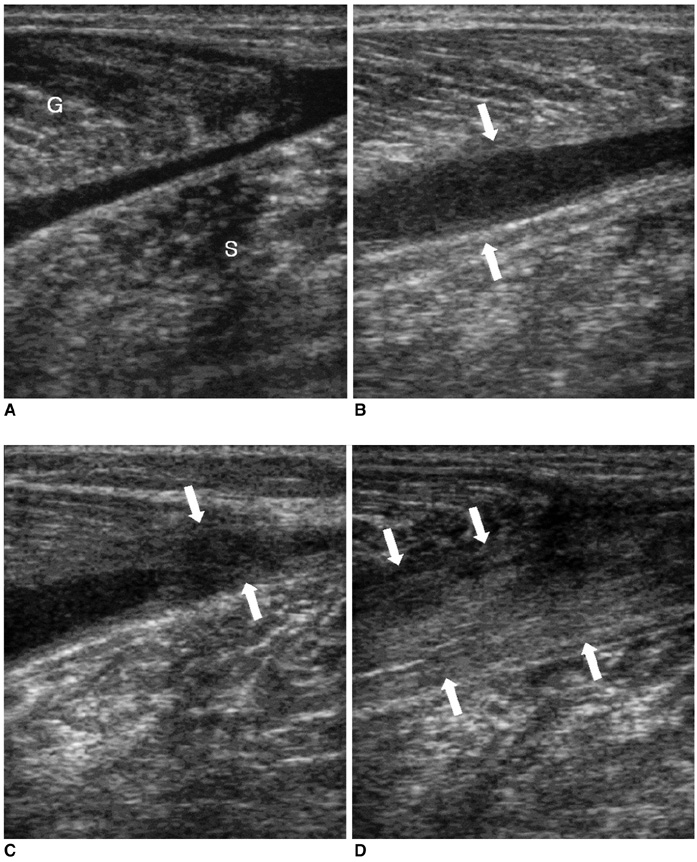Korean J Radiol.
2006 Sep;7(3):193-198. 10.3348/kjr.2006.7.3.193.
Diagnosis and Follow-up US Evaluation of Ruptures of the Medial Head of the Gastrocnemius ("Tennis Leg")
- Affiliations
-
- 1Department of Radiology, Chonbuk National University Medical School, Chonju, Korea. kwak8140@yahoo.co.kr
- 2Department of Orthopedic Surgery, Chonbuk National University Medical School, Chonju, Korea.
- KMID: 1114352
- DOI: http://doi.org/10.3348/kjr.2006.7.3.193
Abstract
OBJECTIVE
The purpose of this study was to demonstrate the ultrasonographic (US) findings of rupture and the healing process of the medial head of the gastrocnemius ("Tennis Leg"). MATERIALS AND METHODS: Twenty-two patients (age range: 30 to 45 years) with clinically suspected ruptures of the medial head of the gastrocnemius were referred to us for US examination. All the patients underwent US of the affected limb and the contralateral asymptomatic limb. Follow-up clinical evaluation and US imaging of all patients were performed at two-week intervals during the month after injury and at one-month intervals during the following six months. RESULTS: Of the 22 patients who had an initial US examination after their injury, partial rupture of the medial head of the gastrocnemius muscle was identified in seven patients (31.8%); the remaining 15 patients were diagnosed with complete rupture. Fluid collection between the medial head of the gastrocnemius and the soleus muscle was identified in 20 patients (90.9%). The thickness of the fluid collection, including the hematoma in the patients with complete rupture (mean: 9.7 mm), was significantly greater than that seen in the patients with partial tear (mean: 6.8 mm) (p < 0.01). The primary union of the medial head of the gastrocnemius with the soleus muscle in all the patients with muscle rupture and fluid collection was recognized via the hypoechoic tissue after four weeks. CONCLUSION: Ultrasonography is a useful imaging modality for the diagnosis and follow-up examination for the patients suffering with rupture of the medial head of the gastrocnemius.
MeSH Terms
Figure
Cited by 1 articles
-
Use of Ultrasonography for Foot and Ankle Sports Injuries
Moon Youngseok, Kim Chong-bin, Hoon Ahn Jae
J Korean Orthop Assoc. 2019;54(5):402-410. doi: 10.4055/jkoa.2019.54.5.402.
Reference
-
1. Gilbert TJ Jr, Bullis BR, Griffiths HJ. Tennis calf or tennis leg. Orthopedics. 1996. 19:179.2. Miller WA. Rupture of the musculotendinous juncture of the medial head of the gastrocnemius muscle. Am J Sports Med. 1977. 5:191–193.3. Bianchi S, Martinoli C, Abdelwahab IF, Derchi LE, Damiani S. Sonographic evaluation of tears of the gastrocnemius medial head ("tennis leg"). J Ultrasound Med. 1998. 17:157–162.4. Delgado GJ, Chung CB, Lektrakul N, Azocar P, Botte MJ, Coria D, et al. Tennis leg: clinical US study of 141 patients and anatomic investigation of four cadavers with MR imaging and US. Radiology. 2002. 224:112–119.5. Shields CL Jr, Redix L, Brewster CE. Acute tears of the medial head of the gastrocnemius. Foot Ankle. 1985. 5:186–190.6. Blue JM, Matthews LS. Leg injuries. Clin Sports Med. 1997. 16:467–478.7. Anouchi YS, Parker RD, Seitz WH Jr. Posterior compartment syndrome of the calf resulting from misdiagnosis of a rupture of the medial head of the gastrocnemius. J Trauma. 1987. 27:678–680.8. McClure JG. Gastrocnemius musculotendinous rupture: a condition confused with thrombophlebitis. South Med J. 1984. 77:1143–1145.9. Straehley D, Jones WW. Acute compartment syndrome (anterior, lateral, and superficial posterior) following tear of the medial head of the gastrocnemius muscle. A case report. Am J Sports Med. 1986. 14:96–99.10. Helms CA, Fritz RC, Garvin GJ. Plantaris muscle injury: evaluation with MR imaging. Radiology. 1995. 195:201–203.11. Hamilton W, Klostermeier T, Lim EV, Moulton JS. Surgically documented rupture of the plantaris muscle: a case report and literature review. Foot Ankle Int. 1997. 18:522–523.12. Bencardino JT, Rosenberg ZS, Brown RR, Hassankhani A, Lustrin ES, Beltran J. Traumatic musculotendinous injuries of the knee: diagnosis with MR imaging. Radiographics. 2000. 20:S103–S120.13. Leekam RN, Agur AM, McKee NH. Using sonography to diagnosis injury of plantaris muscle and tendons. AJR Am J Roentgenol. 1999. 172:185–189.
- Full Text Links
- Actions
-
Cited
- CITED
-
- Close
- Share
- Similar articles
-
- Comparison of Tendon Reflex Responses between Two Heads of Gastrocnemius in Spastic Hemiplegia and Healthy Subjects
- The Co-existence of the Gastrocnemius Tertius and Accessory Soleus Muscles
- Popliteal Artery Entrapment Syndrome caused by a Anomalous Origin of the Gastrocnemius Muscle: Case Report
- An epidemiologic Study of Tennis Elbow in Tennis Player
- MR Imaging of a Bilateral Lateral Segmental Anomalous Origin of the Lateral Head of the Gastrocnemius Muscles: A Case Report



